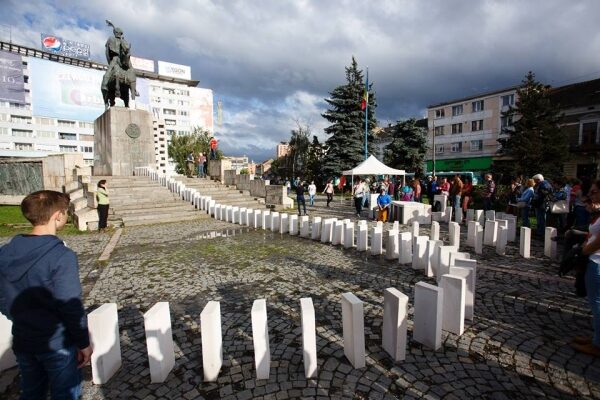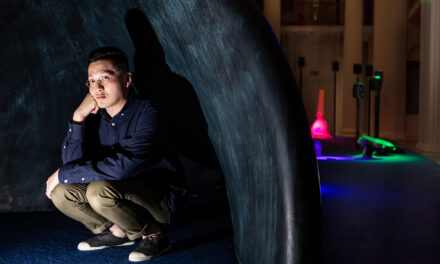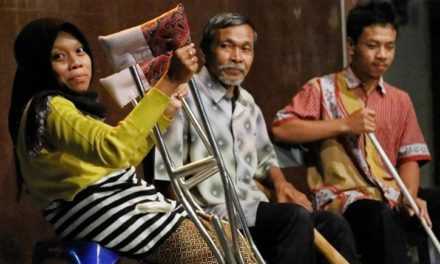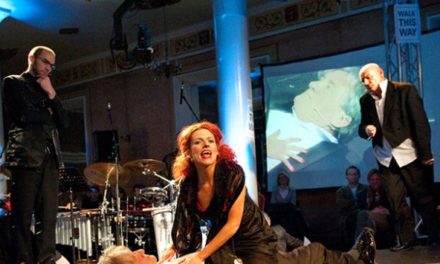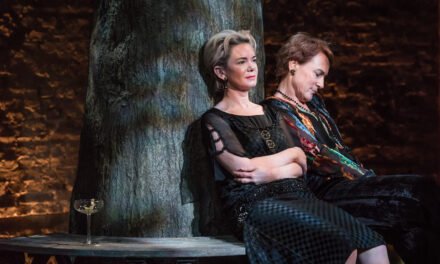Our upcoming Plenary Meeting in Rijeka aims to challenge the most common assumptions and beliefs regarding the theme Audiences. In preparation for the meeting, we commissioned a series of articles with a view of bringing fresh ideas and alternative approaches to the theme. This first essay is written by Nevenka Koprivsek, Artistic Director of Bunker, Slovenia. Nevenka is IETM’s long-standing member and a professional with a great experience in the performing arts field, in the Balkan region and beyond.
IETM has invited me, as a practitioner from the field, to write an article about the theme of audiences, for their upcoming Plenary Meeting in Rijeka. Instead of offering you some structured analysis on audience building, participation and numbers, I am sharing with you some of my personal experiences, ideas, and examples that have been practiced in Slovenia, larger Balkan region or elsewhere. I hope my article will clarify what in my opinion defines the relation between the artist and the spectator, will challenge some of the most common concepts around audiences and give you some insight into the context we work in.
A Flop
During and right after my theatre training at Ecole Jacques Lecoq School in Paris, several students, including myself, worked in one of the Parisian family circuses. Some worked as “garçon de piste”, I was selling nougats, balloons and ice cream, dressed in a funny red costume. One day the owner of the circus proposed us all to work on a new theatre piece. For that reason, he would restore an old tent called Theatre ambulant. It was a beautiful old tent, with an old barrel organ and shiny mirrors in front of it, inviting the audience with colorful written signs: Reduction for family, Magic for all, Soldiers Welcome…etc. It made us dream; we saw ourselves traveling around the globe with this tent and carriages, as in the time of Moliere, and performing on squares of remote towns and small villages. The owner commissioned us to create a piece that could attract and fulfill the taste of all audiences, young and old, a bit funny and a bit moving, definitely with some music and songs. We have happily accepted this offer; we had trust in each other and were eager to throw ourselves on stage. The piece was called Grand Demenagement, the text was actually weak, during the rehearsal process each of us had a small private crisis and some doubts. But after the safe school environment, we felt on the top of the world. Sadly, it turned out to be a fiasco, chaotic, not funny at all. We were lost in tonnes of accessories, and even our singing was rather false. Nothing worked and I remember how ashamed I felt each time I stepped in front of the audience. These two weeks felt like an eternity. I wanted to quit theatre and it took me more than a year to humbly digest and recover from the situation. What I learned from it was that wanting so badly to make a show “for everyone”, satisfy everyone’s taste cannot turn out otherwise than to satisfy no one. It took me years to realize how pretentious it is to think that we know the audience and what they would appreciate. Luckily, this failure turned out to be an important learning experience. I remember this flop each time I am on the other side, as a curator inviting an artist to work in a certain frame or with a certain theme. Never underestimate the audience, there is no way you can enter their minds, above all, they are not dumb, they smell from far away when you want to trick them or to please them too much; theatre can only work when artists who have skills, have also something to say, something that has meaning to them, something with a sense of urgency. It is up to us, programmers and curators to create the right context, and then, only then, there is a chance to eventually touch someone else, maybe one, two, five…
Numbers or quality of experience
It seems we are increasingly trapped in a trendy turmoil of piling more and more of everything: things, relations, events, experiences and also audiences. Numbers of attendees, participants, tickets sold have become one of the most important impact indicators of our work in most of our funding systems, a factor justifying our role in society. But how much do numbers really say about the quality of one’s experience, sensations, thoughts and feelings during or after the performance?
Theatre is a unique form of art, concrete, almost tangible in its physical proximity, terribly ephemeral in the inevitably shared space and time. It is real in its presence and can take us away every moment. It only becomes alive with the first contact with the audience, and it fades out when the show is over. It is obvious it cannot exist without at least one member of the audience. Of course, we all like full houses, but let’s look into the extreme opposite: at a performance for an audience of one.
As a young actress, I was lucky to participate in one of the most legendary examples of such a performance, You – the City, written and directed by Fiona Templeton, created at the end of the 80s in New York. It was touring in London (presented by Artsadmin and LIFT), later also presented by Mickery in Den Haag. I also brought the performance to Ljubljana, to Glej Theatre (one of the first experimental venues in Slovenia, converted from an old horse stable), as a part of my first season as an artistic director. You – the City is an urban passion, re-adopted with local actors in each city, a two-hour walk through the city, each 10 minutes of which are shared with and accompanied by a different actor. We were approximately 20 actors placed in different spots of the city (an office space, park, shopping mall, street, church, pip show, private apartment, and even a car) and approximately 20 people went through “our hands”. By the end of the day, we all met in a bar and talked about what happened. We – the actors – were talking about each member of the audience in the same way as the audience would usually talk about performers. It was all about the quality of interaction: with some it was great, even magic, with others it was boring. There have been many similar attempts of one-to-one performances since then, but to my knowledge, none of them has gone that far. The experience was very intimate and very urban at the same time, and it made us all see not only our audiences but also our cities in a new perspective.
Another meaningful, more recent one-to-one show was the very delicate performance As Far As My Fingertips Take Me by Lebanese director Tania El Khoury, an encounter through a gallery wall between an audience member and an actor. Tania commissioned Basel Zaraa, musician and street artist, who was born in Syria, to record a rap song inspired by the journey his sisters made from Damascus to Sweden. Through touch and sound (the actor was drawing his sister’s itinerary on one’s hand and one could hear him via headphones), without ever seeing each other, this intimate “hand in hand” encounter explores empathy and reveals how we need to literally “feel” the “other” – a refugee, in order to understand the effect of border discrimination on peoples’ lives. It is about borders in our minds, but also about what happens in an invisible shared space between an actor and a spectator.
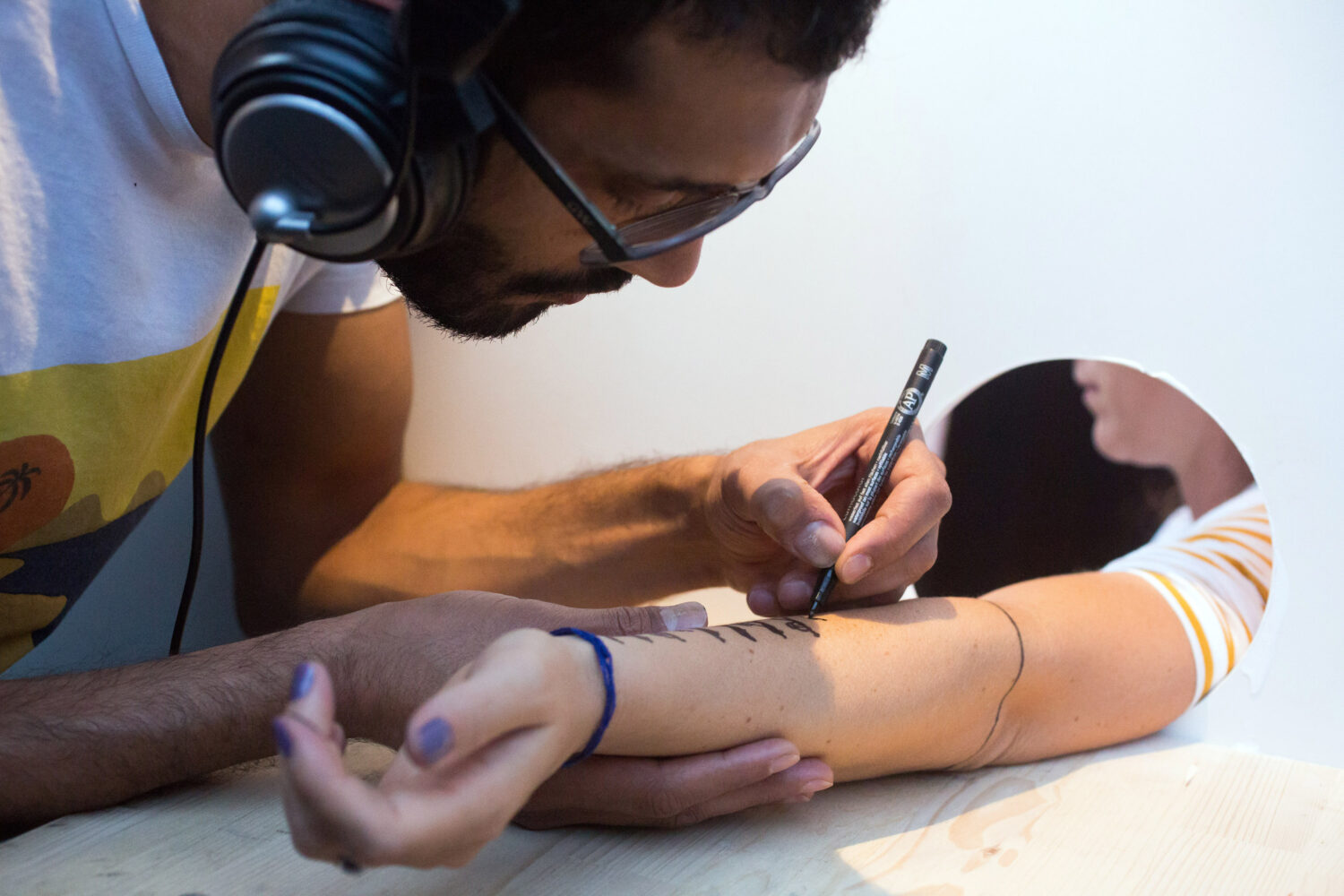
Tania El Khoury at Mladi Levi Festival. Photo by Nada Žgank.
Space
A relation with an audience is very much connected to the physical space. The use of spaces, which often define the relation between a performance and an audience, plays an extremely interesting role in Eastern Europe. In this region, most of the theatre spaces have been for ages inhabited, and in many cases still are, by repertory theatres. With the rise of independent experimental theatres in the 70s and 80s, the need for new forms of performances and related spaces quickly augmented, and artists started appropriating all sorts of spaces and turned them into performing ones: basements, cellars, private apartments, factories, various public spaces or even the non-gravity spaces (cosmos).
For example, the very first performance of Betontanc Company directed by Matjaž Pograjc, which became one of the most internationally renowned Slovene companies, touring worldwide in the 90s, was Poets without Pockets made in a basement of their primary school. It was very poetic and brutal physical theatre; actors’ young bodies were bumping against the concrete floor and narrow corridor walls. The proximity made them breathing with the audience, and one could almost touch them.
Before them, in the 80s, the controversial and established NSK (Neue Slowenische Kunst) and their theatre branch, the Gledelišče sester Scipion Nasice (The Scipion Nasice Sisters Theatre), later Rdeči pilot / Red Pilot also used very unconventional spaces. One of their first shows happened in a private apartment: a spectator had to make a secret appointment and was taken to a mysterious place, where there was a stage with as many holes in it as there were spectators. The audience was seated under the stage with their heads sticking out, so they were right in the middle of the happening. Actors were performing literally above and amongst their heads, making sure not to kick them. The space between actors and spectators was somehow erased.
Another performance of Red Pilot took place in specially converted train wagons in a form of a space shuttle, where the audience was stuck in a dark wagon almost like livestock, before entering the second wagon, where the actual performance happened. Many years later, the same director Dragan Živadinov (now director of Delak, Slovenia) made a performance in the most unconventional space – in a non-gravity space – a real space shuttle. The performance created a distance between actor and spectator to the other extreme, with actually no direct physical presence of the audience.
In all the cases mentioned above, the relation to the audience was also a statement and research of the critical relation between art and power structures (state, church, etc.).
With no or very little access to conventional spaces for independent theatres in the region, the claim of physical space has also meant the claim of mental space, an act of resilience and resistance to the inertness of cultural policy. In Sarajevo, during the war, it has also become an act of heroism. Not only were most of the theatres devastated, but it would have been dangerous for people to gather in them at all. So, the actors from different theatres created an ad hoccompany SARTR (Sarajevo War Theatre) in May 1992, at the beginning of the siege of Sarajevo. It was a form of spiritual resistance to the madness of war. The theatre’s ensemble went to its audience taking the performance to the front-line and shelters on more than one occasion, sometimes performed under candlelight. In total, it showed some 2000 performances during Sarajevo’s four years under siege. The main performance of the Sarajevo War Theatre was the play Shelter which we managed to invite towards the end of the war to Ljubljana. Marina Gržinić (philosopher, theoretician, and artist from Ljubljana) wrote in the program: “The indisputable existence of the theatre under siege was a phenomenon, which was recognized by the media in the notion of cultural resistance“. The main point of the work of the theatre is experiencing, making and discovering the sense of life and digging out memory as an alive complex of life and resistance.”
Shelter was performed in the grotesque genre, and it brought people in Sarajevo some light and laughter in absurd tragedy, as they told us. In Ljubljana, we tried to laugh, but our faces were wet from tears.
So, the urge of exploration of unconventional spaces breaks down the usual top-down relation between artists and spectators (stage up, audience down). It creates a new, potentially more equal relation, conditioned by a concrete spatial and physical presence, even to the point that an artist intervenes in the audiences’ spaces, such as shelters, public spaces or private apartments, or to the other extreme, where the spectator is no longer physically present. It has also a strong political message claiming for more equality between the working conditions of independent artists and the ones engaged in the public sector. It also demands more equal access for audiences willing to invest in a more contemporary, engaged or subversive content.
Public
It is interesting to take a look at how the word “theatre” is translated in some South Slavic languages. The etymology sometimes reflects the different perceptions of the relationship with the audience which were originally most common in a certain culture. In Slovenia, theatre is gledališče, which comes from the verb to watch (gledati), so theatre in Slovenia is the place where we watch a performance (predstava, which comes from the verb to present). So, the theatre is a place where we watch something and someone who has something to show to us. In Croatia, they call theatre kazalište which comes from the verb to say (kazati), so kazalište is the place where performers have to say something to us. In Serbia, they call theatre pozorište, which comes from the word stage (pozornica) – so theatre is meant to be a place where scenic arts are staged in front of the audience.
Putting the etymology aside, since the last decade, there have been lots of debates raised around the theme of audiences, but whatever we consider knowing about approaching our audience, curating it, building it, engaging with it, I am afraid we keep being terribly over-patronizing in relation to it. As if we perfectly knew who our audience is and what is “good” for the “others”.
Rok Vevar, a Slovenian publicist and theoretician in the field of contemporary arts, said in one of the round tables organized by Bunker, that it is not surprising that we talk so much about the audience exactly in times when the public sphere is shrinking. Vevar is pointing out to a “significant change that has taken place since the 1980s and 1990s in Slovenia. If there was an intense and dynamic public sphere at that time (but a lack of public spaces) – now the spaces are available” (at least in the field of theatre, we have many more venues available to the independent sector), “but the public sphere is completely eroded. This commoditized form of the public is called an audience today, and it must be produced at a time when the public sphere is falling apart.” Indeed, during the transition times in our region, more and more of what used to be common, publicly accessible, has been largely privatized. For example, media are more and more privatized and offer much less space for socially and politically relevant themes, not only in the region but also globally. It is thus not surprising that documentary theatre is fueled precisely by this lack of a public discussion of certain socially relevant topics.
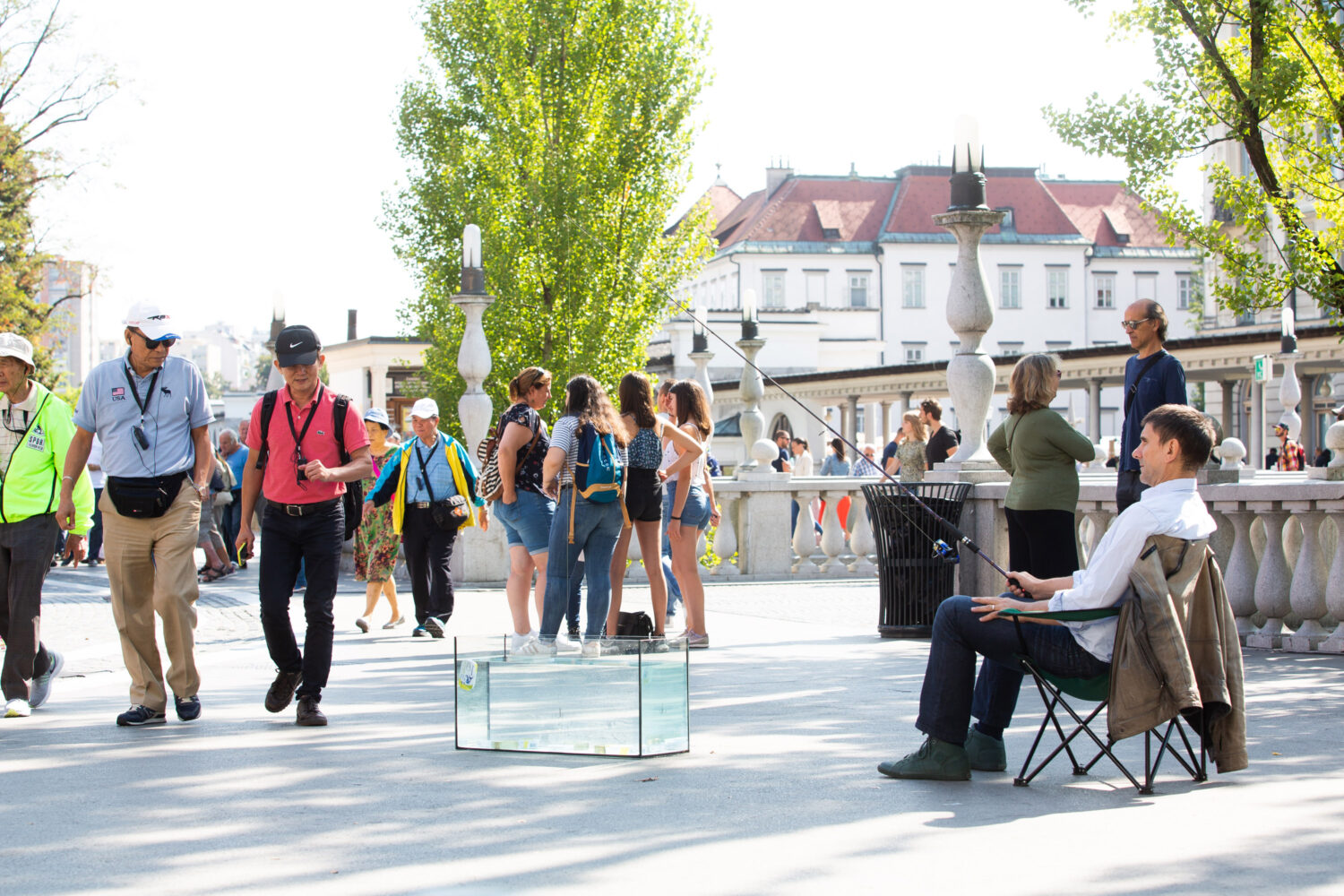
Sinisa Labrovic’s Fishing at Mladi Levi Festival 2018. Photo by Nada Žgank
Participation
There is no universal form of audience participation, and the desire to upgrade, revive, revolutionize the relation between actor and spectator is being reinvented all over again. We can call it emancipation, integration or simple invitation into a more active kind of audience engagement. Participation is still probably one of the most widely used praxis when we attempt to emancipate the spectators, as some might say, from their passivity. I would like to describe three examples of different artists from our region, who made their name in the field of contemporary art much before the “participatory praxis” became a mantra. In my view, their honest exploration of the relation between the artist and the audience goes way beyond the annoying patronizing approach.
Marina Abramović
Marina Abramović is a pioneer in developing and testing the most extraordinary relationship between the performer and the audience. In one of her best-known and probably most challenging performances Rhythm 0, in 1974, she assigned a passive role to herself, with the public being the force that would act on her. Abramović placed on a table 72 objects that people were allowed to use in any way that they chose. Some of these were objects that could give pleasure, while others could be wielded to inflict pain, or to harm her. Among them were a rose, a feather, honey, a whip, olive oil, scissors, a scalpel, a gun, and a single bullet. For six hours the artist allowed the audience members to manipulate her body and actions.
Visitors were gentle to begin with, offering her a rose or a kiss. As Abramović described it later: “What I learned was that… if you leave it up to the audience, they can kill you… I felt really violated: they cut up my clothes, stuck rose thorns in my stomach, one person aimed the gun at my head, and another took it away. It created an aggressive atmosphere. After exactly 6 hours, as planned, I stood up and started walking toward the audience. Everyone ran away, to escape an actual confrontation”.
Škart
Škart, a Serbian art collective, has been thoroughly, for many years, exploring the relationship between an artist and audience in a completely different way. It all started in 1990, at the Faculty of Architecture in Belgrade. While experimenting through their work, they have been primarily working with poetry and design, as well as with some performative aspects. They have been gradually trying to fade away behind their exploration, putting the protagonist of their actions to the foreground. Basically, participants, ordinary people, become central in Škart’s projects, and not the artists themselves. They describe their concept as “architecture of the human relationships” collaboratively developing new values. Their numerous works include chorus singing – Horkeškart, Collective Poetry Writing, playing with absurd objects, and many more. One of their recent projects is called Impractical Women, which involves archaic and marginal format of embroidery with a view of unleashing their satirical thoughts and creating an amusement closely intertwined with sharp social criticism (questioning the role of today’s ordinary women). What I admire the most about Škart’s approach is that they care for the people they involve in their projects way beyond the project’s life span and seek a sustainable and continuous artistic process. This is unlike practices of many artists who use a participatory approach and “profit” from people’s stories, putting them in the spotlight only temporarily and abandoning soon after the project is done.
Siniša Labrović
Siniša Labrović, a performer and conceptual artist from Croatia, combining body art, visual art, action, and installations in public spaces or exhibitions, uses yet another approach to the audience. This ingenious artist seems not to care for audiences at all. When performing in a public space, he does not try to seduce or attract people. Yet his ambiguous actions, which often address challenging societal phenomena, provoke and intrigue accidental passengers. Labrović’s topics range from nationalism and hypocrisy of the Catholic Church to the absurdity of reality shows. One of his most notable projects was stado.org (“stado” means “herd”) – a reality show with 7 sheep. Labrović posted online episodes of the daily life of the sheep, organizing daily programs for them, such as “a day of critical watching of TV”, or readings by prominent Croatian writers. The show captured the attention of the viewers by prize games and voting for the sheep. In the frame of the Mladi Levi festival, he has done a durational performance Fishing: on the popular Prešeren Square, near three bridges, he was seated by the small aquarium filled with water and fishing fish cans from it. His approach is sharp and absurd, critical of the society and at the same time completely open to the imagination and interpretation of an accidental audience.
These three examples are just a few amongst many different attempts of involving audience members in direct interaction with artists and their artwork. But participation or not, as long as we are aware of what we are doing, of various pitfalls that participation can imply, from manipulation to unexpected violence, it is always about testing this invisible space between the performer and their spectator. And this relation has to be reinvented and discussed over and over again.
Where Do We Stand?
It must be obvious by now that in this article I would like to turn attention away from the persistent demands of increasing audiences, imposed by our funders or ourselves, and focus on the relation between us: artists, curators, art workers, and various audiences. However, we do not need a deep analysis to observe that today’s theatre audience in Europe mainly consists of white, educated and rather wealthy social class. This for sure does not reflect the full picture of the Europen society today, which is polarised, segmented and in many cases socially segregated. One cannot avoid seeing the absurdity of public calls for art and culture projects focused on working with marginal groups, refugees, etc. at the time when our governments make policy which blocks the entrance of refugees and pushes them back, denying them of the rights to mobility which we “Europeans” take for granted. So the demands of better social inclusion that arts can contribute to (imposed either by our founders, media or ourselves) are rather hypocritical, as they often tend to masquerade the actual approach of decision-makers towards the migration issue. I do not believe that the arts can be a corrective tool or a patch on the wounded society. I do not believe that art can change society, but it might change our relationship to it. What we take or what we give each of us or as a community. We need constantly to provide spaces for open laboratories, we need to experiment and look for ways to produce art for people or even amongst people, seek participatory strategies based on creating process and strengthen spaces of public engagement and constantly search for ways to reach the unusual suspects.
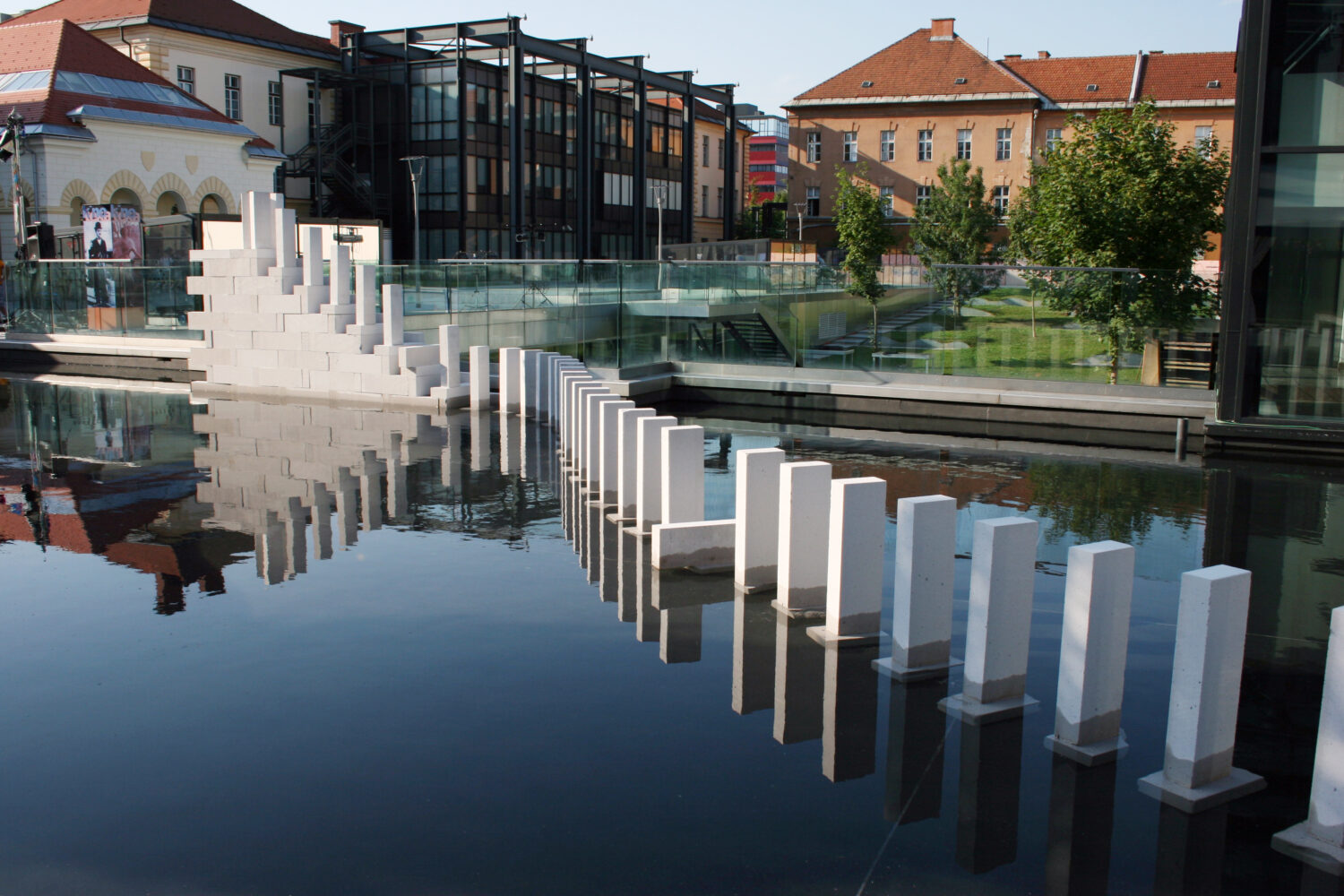
Dominoes by Station House Opera at Mladi Levi Festival 2011. Photo by Urska Boljkovac
Cultural Education
Investing in young audiences is definitely one of the most concrete answers and interesting approaches to engaging with the “audience to be” that I have witnessed in the last years. My brilliant collaborator from Bunker, Alma R.Selimović has been exploring and developing cultural education methods, with great success.
Started in the 50s in ex-Yugoslavia, there has been a wonderful program called Šola v naravi (School in Nature) where kids spend a certain time in nature, doing sports and exploring different parts of Slovenia. Alma has turned this concept into Šola v kulturi (School in Culture) in collaboration with 20 schools from different parts of Slovenia. Kids, teenagers, and teachers are coming to an urban area and explore cultural life (theatre, dance, film, urban walks, various workshops, etc.). They experience contemporary, sometimes subversive art, not just art created for children. They sleep (camp) in the auditorium of our theatre (Stara elektrarna) or other venues, and for many of them, it is their first time in the city away from their parents. They are constantly accompanied and everything that they see and experience is discussed with them, they can talk with artists and share their opinion after or during moderated discussions.
Another good example from the Bunker program of working with schools (Playground for schools) is the tandem hours where a teacher and an artist prepare a class together. It is not just about learning about the arts but also through the arts. It is increasingly obvious that we can learn only, or learn better when we learn with the whole of ourselves. And theatre can be the best polygon for that. The feedback from the young people is often just amazing and gives me goosebumps, it brings me back to my teenage years and reminds me why I got interested in theatre in the first place. As Alma often says, if you miss them now, in their tender age, you may miss them for their entire life, but if their experience is good, they may come back as adults. By the end of the day, it is all about a wonderful collectively shared experience that theatre can provide, in a conventional or unconventional setting. So, no matter if it is a performance for an audience of one, or an event for a crowd, it is this feeling of temporary community that can be so nicely shared and people like to be part of. The time when we can become more open, more thoughtful, more compassionate, a bit more human and more part of society.
Quinn Houben, a three-year-old son of a good friend of mine, was watching the wonderful moving installation Dominoes staged by Station House Opera (Artsadmin) and executed with 90 volunteers from our neighborhood. It was a serpent line of thousands of brick blocks, which were used to create a two-kilometer long, domino-like sculpture crossing the river bridge, passing by the buildings and streets. On the other end, we were watching it live-streamed on a big screen. Everybody running around and after the falling bricks, was in a kind of ecstasy, screaming of excitement and simply wanting this long falling installation to work. Some said afterward that it had produced a feeling of happiness of doing something collective for “nothing”, just from goodwill. After this short but intense 10-minute run, Quinn looks at his father and exclaims: AGAIN!!! I believe all the secrets of why people come back to the theatre lie exactly there: we want to live this experience of feeling and sensing together, in joy or sorrow, inaction or contemplation, again and again.
This article was originally posted at IETM.org and has been reposted with permission. To read the original article, click here.
This post was written by the author in their personal capacity.The opinions expressed in this article are the author’s own and do not reflect the view of The Theatre Times, their staff or collaborators.
This post was written by Nevenka Koprivšek.
The views expressed here belong to the author and do not necessarily reflect our views and opinions.

